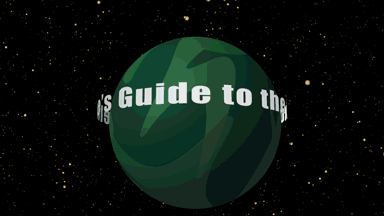Scienceline’s Guide to the Exoplanets: Strange Earth
Gliese 667 Cc: An Earth in different circumstances
Rahul Rao • September 14, 2020

Your favorite planets, and you didn't even know they existed. [Credit: Curtis Segarra | CC BY-NC-ND 2.0]
Strange Earth
Gliese 667 Cc
Discovered by: HARPS
Discovered: 2011
Distance from Earth: ~24 light-years
Mass: about 3.7 Earth masses
Radius: about 1.5 Earth radii
Surface climate: Fading hopes
Habitability for humans: A mystery
Imagine an Earth with three suns. Well, maybe a planet not quite like Earth.
Gliese 667 is a triple star system located in the direction of Scorpius. Two of this happy family’s stars, Gliese 667 A and B, are orange stars; they’re both just over two-thirds the mass of the Sun. The family’s third member, then, is a red dwarf, less than half the size of its counterparts in its system.
The planet we’re looking at lives in orbit around that third star. At least two planets orbit that red dwarf; some observations have claimed as many as five planets, but it seems likely that some of those five are false positives.
Gliese 667 Cc, on the other hand, has been confirmed, and we know a few things about it. We know that it’s rocky, and not much larger than Earth. We know that it rests comfortably in its star’s habitable zone, making it possible that fun things like liquid water could exist there. We know that its equilibrium temperature — the temperature it would be were it a featureless object in space, with no atmosphere or anything to move heat around — is just a few degrees above water’s freezing point.
We also know that it’s tidally locked: that one side eternally faces its sun.
We’ve seen tidally locked planets in this space before, but many of them were close to their stars; they would have been uninhabitable and infernal even without the added fun of being locked in perpetuity. What does a tidally locked planet deep within the habitable zone look like? What if, say, one side of the Earth were to always bathe in sunlight?
A huge part of the answer depends on whether or not this planet has an atmosphere. Moving gases can and do transfer heat all across a planet, helping to equalize temperatures. If Gliese 667 Cc had an atmosphere — something which astronomers still aren’t sure of — then it’s possible that much of the planet’s night side might actually be quite pleasant.
Then again, as we’ve learned more about Gliese 667 Cc’s orbit, the more we’ve discovered that it drifts further and further from anything Earthlike. In 2013, scientists discovered that its eccentric orbit — itself a bad sign for habitability — dramatically and violently pulls and stretches the planet’s interior.
The result is tidal heating, 300 times more powerful than anything seen inside Earth. That could mean another source to beautify the night side — or, as is far more likely the case, it could mean that tectonics and volcanoes tear the surface apart, making it too unstable to support anything like Earth-life.